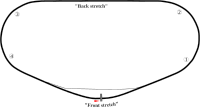UNO Twin 125
 |
|
 |
|
| Venue | Daytona International Speedway |
|---|---|
| Location | Daytona Beach, Florida, United States |
| Corporate sponsor | Bombardier Recreational Products |
| First race | 1959 |
| Distance | 150 miles (241.401 km) |
| Laps | 60 |
| Previous names |
100 Mile Qualifying Races (1959–1967) 125 Mile Qualifying Races (1969–1980) UNO Twin 125 Qualifiers (1981–1984) 7-Eleven Twin 125's (1985–1987) Twin 125 Qualifiers (1988–1990) Gatorade Twin 125 Qualifiers (1991–1993) Gatorade Twin 125's (1994–1996) Gatorade 125's (1997–2004) Gatorade Duel (2005–2012) Budweiser Duel (2013–2015) Can-Am Duel (2016–present) |
| Most wins (driver) | Dale Earnhardt (12) |
| Most wins (team) | Richard Childress Racing (15) |
| Most wins (manufacturer) | Chevrolet (52) |
| Surface | Asphalt |
| Length | 2.5 mi (4.0 km) |
| Turns | 4 |
The Can-Am Duel, formerly known as the Twin 125s, is a Monster Energy NASCAR Cup Series preliminary event to the Daytona 500 held annually in February at Daytona International Speedway. It consists of two 150-mile (240 km) races, which both serve as a qualifying race for the Daytona 500. The finishing order in the two 150-mile (240 km) races, held on the Thursday before the Daytona 500, determine the starting lineup for the Daytona 500 held on race day.
Qualifying for the Daytona 500 is unique in NASCAR. Only the two front row starters (the pole and "outside pole") are determined by the standard knockout qualifying system. For all other drivers it only determines their starting position in their duel with odd placed cars being entered into the first duel and even placed cars going in the second. After the Top 2 positions are locked in, the next 30 places of starting grid of the Daytona 500 is set by the finishing order of these two races with the top 15 (excluding pole winner and outside pole) making up the next 15 places on the inside and outside lanes respectively. After the Duels are completed the four fastest non-qualifiers by time and finally the six or seven (if no past champion's exemption is needed) highest-earning teams in points not in the race yet advance (also set by time), and the starting grid for the Daytona 500 would then be set. The order is still subject to change if engine regulations are violated.
The event began as twin 100-mile (40-lap) races. From 1959–1971, the races were counted with points towards the Grand National championship. Purses awarded were counted separately from those awarded in the Daytona 500. For 1968, the races were scheduled for 125 miles (201 km) each, but were cancelled due to rain, and the starting lineup for the 1968 Daytona 500 fell back on the timed laps. In 1969, the races were extended again to 125 miles (50 laps).
For 1972, NASCAR's modern era commenced, and the races were dropped from the Grand National schedule as points-paying championship events. As part of Winston's changes to the series, races were required to be at least 250 miles (400 km) to be included as official points events. The races continued, however, as a non-points event. CBS began covering the event in the early 1980s, airing them tape-delayed and edited the day before the Daytona 500.
With the introduction of restrictor plates in 1988, the resulting reduction in speed and fuel consumption again allowed drivers to possibly complete the race without a pit stop. Nine times from 1988–2004, one of the races went without a caution, and without a pit stop by the winner. In 2003, rules had been put in place requiring smaller fuel tanks on restrictor plate track (from 22 US gal (18 imp gal; 83 l) down to 13 US gal (11 imp gal; 49 l)), which effectively forced a pit stop.
...
Wikipedia
